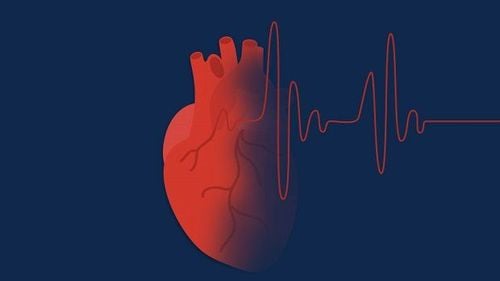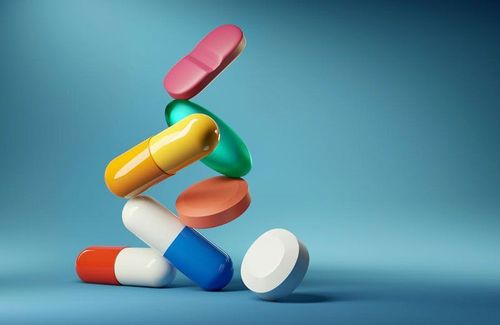This is an automatically translated article.
Adenocard is a drug indicated for the treatment of cardiac arrhythmias. To better understand what Adenocard is, its use, let's learn more in the article below.
1. Uses of Adenocard
Before going to learn about the use of Adenocard, let's answer the question what is Adenocard?
Adenocard is a prescription medication used to treat symptoms of paroxysmal supraventricular tachycardia (PSVT) and also used during a cardiac stress test. Adenocard can be used alone or with other medicines. Adenocard belongs to a class of drugs called antiarrhythmic drugs.
Intravenous adenosine (adenosine injection) has been used effectively in the presence of other cardioactive drugs, such as quinidine, beta-adrenergic blockers, calcium channel blockers, and ACE inhibitors, without any change in adverse reaction profile.
Adenocard has a sinus-conversion effect of paroxysmal supraventricular tachycardia (PSVT), including heart rate associated with accessory branch pathways (Wolf-Parkinson-White syndrome). When clinically recommended, appropriate vagal maneuvers (eg, Valsalva maneuvers) should be attempted prior to administration of Adenocard. It is important to ensure that the Adenocard solution actually reaches the systemic circulation.
Adenocard does not convert atrial flutter, atrial fibrillation, or ventricular tachycardia to normal sinus rhythm. In the presence of atrial flutter or atrial fibrillation, transient slow ventricular response may occur shortly after administration of Adenocard.
2. Clinical pharmacology
2.1. Adenocard (adenosine injection) slows conduction time across the A-V node, may disrupt conduction through the A-V node, and may restore normal sinus rhythm in patients with paroxysmal tachycardia. PSVT, including paroxysmal supraventricular tachycardia associated with Wolff-Parkinson-White Syndrome.
Adenocard is competitively antagonized by methylxanthines such as caffeine and theophylline, and enhanced by nucleoside transporter blockers such as dipyridamole. Adenocard is not blocked by atropine.
2.2. Hemodynamics of Adenocard An intravenous bolus of 6 or 12 mg of Adenocard (adenosine injection) will generally have no systemic hemodynamic effects. When infusion in larger doses, adenosine lowers blood pressure by reducing peripheral resistance.
2.3. Pharmacokinetics of Adenocard Intravenous Adenosine is rapidly eliminated from the circulation by cellular uptake, primarily by red blood cells and vascular endothelial cells. This process involves a specific transmembrane nucleoside carrier system that is reversible, nonlocal, and bidirectionally symmetric. Intracellular adenosine is rapidly metabolized by phosphorylation to adenosine monophosphate by adenosine kinase, or by deamination to inosine by intracellular adenosine deaminase. Since adenosine kinase has a lower Km and Vmax than adenosine deaminase, deamination plays an important role only when cytosolic adenosine saturates the phosphorylation pathway. Inosine formed by the reduction of adenosine can leave cells unaffected or can be broken down to hypoxanthine, xanthine and finally uric acid.
Adenosine monophosphate formed by phosphorylation of adenosine is incorporated into the high energy phosphate group. While extracellular adenosine is primarily eliminated by cellular uptake with a half-life of less than 10 seconds in whole blood, excessive amounts may be eliminated by a form of ecto-adenosine deaminase. Since Adenocard does not require liver or kidney function for activation or inactivation, liver and kidney failure will not alter the effectiveness or tolerability of the drug.
3. How to use and dosage of Adenocard
3.1. How to use Adenocard is for rapid intravenous bolus use only. Adenocard (adenosine injection) should be given as a rapid infusion through a peripheral vein. To ensure that the solution reaches the systemic circulation, it should be administered either directly into a vein or. If administered intravenously, it should be administered as close to the patient as possible and followed by rapid saline flushing.
3.2. Dosage 3.2.1. For adults Dose recommendations are based on clinical studies for peripheral intravenous dosing. The use of Adenocard through a central venous line (CVP or otherwise) has not been systematically studied. The recommended intravenous dose for adults is also as follows:
The starting dose is 6 mg IV rapidly (injected at 1-2 second intervals). Repeated administration: If the first dose does not eliminate supraventricular tachycardia, within 1-2 minutes, 12 mg should be infused as a rapid intravenous bolus. This 12mg dose will be able to be repeated a second time if required. 3.2.2. For children Doses used for infants, infants, children and adolescents are equivalent to those used for adults on a weight basis.
Pediatric patients with body weight < 50 kg: Initial dose: Give 0.05 to 0.1 mg/kg as a rapid central or peripheral intravenous injection. Should be washed with salt water. Repeat administration: If PSVT transfer does not occur within 1-2 minutes, additional adenosine injections can be given at progressively higher doses, increasing the amount given from 0.05 to 0.1 mg/kg. After each wash, wash with physiological saline. This process should continue until sinus rhythm is established or use a maximum single dose of 0.3 mg/kg. Pediatric patients with body weight ≥ 50kg: Use adult dose. Doses greater than 12mg are not recommended for adult and pediatric patients. Note: Medicinal products for parenteral use must be visually inspected for particulate matter and discoloration prior to use.
3.3. Handling Overdose The half-life of Adenocard (adenosine injection) is less than 10 seconds. As a result, side effects are usually rapidly self-limiting. The treatment of any persistent adverse events should be individualized and effect-specific.
Unusual manifestations of overdose should be reported to the doctor or medical person in charge. In case of an overdose of Adenocard 3mg/ml with symptoms, it is necessary to have an emergency: Call 911 immediately for guidance and help. Family members should bring medical records, all prescriptions / bottles of medicine that have been used and are being used by doctors so that doctors can quickly diagnose and treat.
3.4. Handling missed doses Usually drugs can be taken in 1-2 hours longer than prescribed in the prescription. Unless there's a strict rule on how long to take it, you can take it a few hours after you notice it's forgotten. However, if the time is too far from the time you need to drink, you should not make up for it, because it can be dangerous to the body. It is necessary to comply or consult a doctor before making a decision.
4. What are the possible side effects of Adenocard?
Adenocard can cause serious side effects including:
Irregular heartbeat Chest pain Early atrial heartbeat Irregular heartbeat (such as too fast or too slow) Shortness of breath Feeling of tightness in the throat Heart attack Nausea, headache Sweating Palpitations Low blood pressure (hypotension) Hyperventilation These are not all possible side effects of Adenocard. For more information ask your doctor or pharmacist.
5. Notes before taking Adenocard
Patients should not be treated with Adenocard if they have a serious heart condition such as “sick sinus syndrome” or “AV block” (unless you have a pacemaker) or a slow heart rate that makes you faint. Your doctor will perform tests to make sure you don't have conditions that would prevent you from safely receiving Adenocard.
In addition, tell your doctor if you have ever had:
Asthma, COPD, bronchitis, emphysema or other breathing problems; Convulsions Angina (chest pain). Pregnant women and nursing mothers should exercise caution and consider their doctor's advice before taking this medicine.
6. How to store Adenocard
Adenocard should be stored at a controlled room temperature of 15o-30oC (59o-86oF). Do not refrigerate as crystallization may occur. If crystallization occurs, dissolve the crystals by warming to room temperature. The solution must be clear at the time that you use it.
Please dial HOTLINE for more information or register for an appointment HERE. Download MyVinmec app to make appointments faster and to manage your bookings easily.













